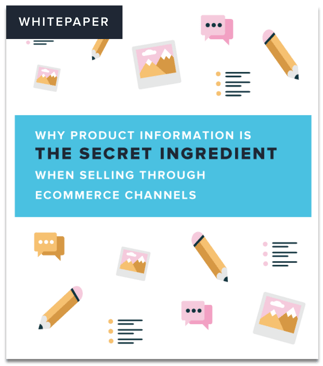
Takeaway: Product information management (“PIM”): essential to aggregating, managing, and collaborating on data and consumer-facing content. So important, Forrester recently declared, “PIM is indispensable in the new era of distributed commerce.” If your company is thinking about investing in content and syndication efforts via a PIM system, read on for key need-to-knows.
PIM. Chances are you’ve been in a team meeting and tossed the acronym around without understanding fully the definition and meaning of Product Information Management (PIM). And the fact that a 2014 Forrester report indicated, “33% of eBusiness and channel strategy professionals cited investment in PIM technology was a top priority,” you aren’t alone.
So, what is PIM in 30 under words?
We define PIM as: A central repository that stores product information like marketing copy, feature descriptions, and logistics details and provides the data brands and retailers need to sell across the digital ecosystem.
To explain a little further, without a centralized location for every stakeholder to view and access product information, organizations rely on time consuming, spreadsheet-based, manual processes that make it impossible for them to meet the growing demands of today’s commerce market. Different than Master Data Management (MDM) that’s for internal technological use, PIM helps to consolidate, manage, improve and publish consumer-facing product information and digital assets to your retail, marketplace, and e-commerce channels.
What are the top goals and KPIs of PIM?
- Increase sales and lower return rates by improving the accuracy of consumer-facing product content and data
- Proof: “64% of U.S. online adults today shop online because the product presented there is more informative than what’s in-store”
- Push products to market faster and more efficiently, maximize product life cycles, release larger product assortments by housing content in single, trusted location that is easily accessible and useable by all internal stakeholders like marketing, creative, sales, brand managers, and merchandising
- Create a consistent consumer experience and increased brand loyalty by distributing accurate and complete content to external retailers and channels
- Proof: “30% of US online adults cite that they would consider buying from an online retailer they had never previously purchased from if the retailer offered detailed product information”
What are PIM industry trends to seek?
According to the Forrester Wave, Product Information Management Solutions, Q4 2016 report, industry professionals are looking for “self-service, connectivity, and automation,” meaning secure 24/7 access to cloud-based data is vital. Brands and retailers want to manage the content themselves in real time through vendor portal tools, and not deal with delayed, outsourced updates. This calls for the right technology to allow them easy access and usability, along with handholding by the PIM provider when needed.
Additionally, syndication is essential and, like PIM, often misunderstood. In today’s distributed, omnichannel commerce landscape, syndication allows all or parts of content to be disseminated to each commerce channel, retailer, and search engine.
Finally, experiential content, like videos and how-tos, is the new consumer expectation. PIM software must include systems for housing and distributing these brand immersion tools as demanded by heavy-hitters like Google and Amazon.
To summarize, what are the benefits to adopting PIM technology?
- Increase sales through quick and efficient syndication
- Improve your team’s productivity through automatically updated smart lists
- Identify and fill internal product content gaps by mapping information to each channel’s unique requirements
- Ensure data accuracy and consistency by providing a single, cloud-based location for accessing approved product content
- Integrate data from multiple sources securely and accurately
- Layer the PIM system seamlessly on top of existing data management systems

Written by: Salsify
Salsify helps thousands of brand manufacturers, distributors, and retailers in over 140 countries collaborate to win on the digital shelf.
Recent Posts
Do Brands Need Social Media Influencers In The Age of AI?
How Can Brands Align With Consumers’ New Year’s Resolutions?
5 Ecommerce Tips To Help Marketers Enter the New Year Stress-Free
Subscribe to the Below the Fold Newsletter
Standing out on the digital shelf starts with access to the latest industry content. Subscribe to Below the Fold, our monthly content newsletter, and join other commerce leaders.

.svg)